- ---
Project Index -
BENTEN 2024BENTEN 2024 2024
ナラッキーNa-Lucky 2023
DOBUROKGEOLLIDOBUROKGEOLLI 2022
いつのことだか思いだしてごらんいつのことだか思いだしてごらん 2022
改名Name Change 2022
くらいんぐみゅーじあむCrying Museum 2022
SUNSUN 2022
はい、こんにちは Hello There 2020
May, 2020, TokyoMay, 2020, Tokyo 2020
A Drunk PandemicA Drunk Pandemic 2019
にんげんレストランNingen restaurant 2018
道Street 2017-
The other side 2017
Scrap & Build 2 2017
Scrap & Build 2016
Don't Follow The Wind initiated by Chim↑Pom 2015-
堪え難きを耐え↑忍び難きを忍ぶ10th ANNIVERSARY EXHIBITION 2015
金三昧KANE-ZANMAI 2014-
パラドックスPARADOX 2014
LOVE IS OVER 2014
マッドエリイMAD ELLIE 2013-
GARBAGE 2012-
PAVILION 2012-
REAL TIMES 2011
パズルPUZZLE 2011,2014-
IMAGINEIMAGINE 2010
BLACK OF DEATH 2008,2013
広島HIROSHIMA 2008-
日本のアートは10年おくれている 世界のアートは7,8年おくれているJAPANESE ART IS 10 YEARS BEHIND, AND ART OF THE WORLD IS 7 OR 8 YEARS BEHIND. 2008
友情か友喰いか友倒れかBecoming Friends, Eating Each Other or Falling Down Together 2008
TPA 2007
サンキューセレブプロジェクト・アイムボカンTHANK YOU CELEB PROJECT "I'M BOKAN" 2007
ともだちTOMODACHI 2007
オレオレORE-ORE 2007
エロキテルEROKITEL 2007-
スーパーラットSUPER RAT 2006-
BODY 2005-
- ---
Overview open/close -
2014-
Chim↑Pomは2014年からアメリカの国境問題をテーマとした《COYOTE》(2014)、《U.S.A. Visitor Center》(2016)、《LIBERTAD》(2017)、《The Grounds》(同)を制作。プロジェクト全体のタイトルを、メキシコのアメリカ国境沿いに住む人々がアメリカを呼ぶときのニックネーム「the other side」とした。エリイが抱えるアメリカへの入国規制という個人的な問題にフォーカスしたものだが、福島第一原発の事故によってできた帰還困難区域や、世界中の移民や難民の問題、あらゆる国境やボーダーなど、現存するさまざまな「向こう側」への想いが込められている。 2014-
Starting from 2014, Chim↑Pom created works themed on the US -Mexico border issue, including COYOTE (2014), U.S.A. Visitor Center (2016), LIBERTAD and The Grounds (both 2017). The entire project is named after the way people on the Mexico side of the border refer to the U.S.A. These successive projects are focused on Ellie’s personal problem regarding her denied entry into the U.S.A., but the title also alludes to various “other sides” that currently exist, such as the nuclear exclusion zone produced by the Fukushima Daiichi Nuclear Power Plant disaster, or the numerous border issues involving immigrants and refugees across the world.
- ---
Index open/close -
The other sidethe other side
COYOTECOYOTE
U.S.A. Visitor CenterU.S.A. Visitor Center
The GroundsThe Grounds
LIBERTADLIBERTAD
- ---
Media open/close -
"The Los Angels Times"As Trump talks building a wall, a Japanese art collective's Tijuana treehouse peeks across the border 23/1/2017
PDF
PDF
"The San Diego Union Tribune"How avant-garde Japanese artists found inspiration in Tijuana 13/1/2017 PDF PDF
"HYPERALLERGIC"In Tijuana, an Artist-Designed Treehouse Gives a Peek into the US 2/2/2017 PDF PDF
"AZURE magazine"Instead of Trump’s Wall, a Treehouse on the U.S.-Mexico Border 31/1/2017 PDF PDF
"CREATORS"A Japanese Art Collective Had a Funeral for Liberty on the US–Mexico Border 11/2/2017 PDF PDF
"毎日新聞"米国の壁 アートで風穴…日本の美術家集団が制作 10/2/2017 PDF PDF
"The Los Angels Times"As Trump talks building a wall, a Japanese art collective's Tijuana treehouse peeks across the border 23/1/2017 PDF PDF
"The San Diego Union Tribune"How avant-garde Japanese artists found inspiration in Tijuana 13/1/2017 PDF PDF
"HYPERALLERGIC"In Tijuana, an Artist-Designed Treehouse Gives a Peek into the US 2/2/2017 PDF PDF
"AZURE magazine"Instead of Trump’s Wall, a Treehouse on the U.S.-Mexico Border 31/1/2017 PDF PDF
"CREATORS"A Japanese Art Collective Had a Funeral for Liberty on the US–Mexico Border 11/2/2017 PDF PDF
"MAINICHI News Paper"10/2/2017 PDF PDF
- ---
COYOTECOYOTE open/close -
2014
エリイが抱えるアメリカへのイミグレーション問題をベースにした、インスタレーション作品。「コヨーテ」と呼ばれるメキシコからの密入国斡旋業者について話し合う、ギャラリースタッフとのミーティングを収めたSkypeビデオと、動物のコヨーテと行うだろうパフォーマンスの準備だけがギャラリーに展示された。ヨーゼフ・ボイスのパフォーマンス《コヨーテ─私はアメリカが好き、アメリカも私が好き》から引用している。ニューヨークという現実の場所を作品のステージにしながらも、「現地制作ができない/許されていない」エリイは、インターネットでしかパフォーマンスを行えず、自らインスタレーションを作ることができない。ボイスがコヨーテとパフォーマンスを行ったときとは異なり、2014年のギャラリーにはアーティストもコヨーテもいなかった。
2014
An installation work based on the issue of Ellie’s denied entry into the U.S.A. A video of a Skype meeting conducted between Chim↑Pom and a gallery staff in New York discussing human traffickers - so-called “coyotes” - and also the preparation scenes of a possible performance with the animal were exhibited in the gallery. The installation makes reference to the pivotal performance Coyote: I Like America and America Likes Me (1974) by Joseph Beuys. Even though the work is staged in New York, the performance could only happen through the Internet because Ellie was unable to make the work herself, or is not allowed to do so. The time when Beuys did his performance with a real coyote, there is no artist or “coyote” to perform in the gallery at the present time.
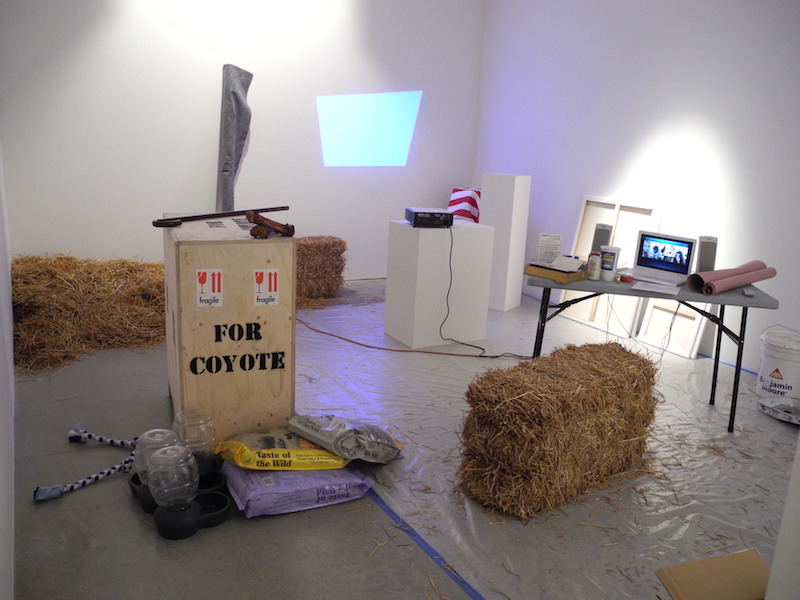
COYOTE
2014
展示風景:「Duality of Existence - Post Fukushima: A Group Exhibition of Contemporary Japanese Art」(Friedman Benda、ニューヨーク、2014年)
撮影:Adam Reich
Courtesy of the artist and MUJIN-TO ProductionCOYOTE
2014
Installation view: “Duality of Existence - Post Fukushima | A group exhibition of Contemporary Japanese Art” (Friedman Benda, New York, 2014)
Photo: Adam Reich
Courtesy of the artist and MUJIN-TO Production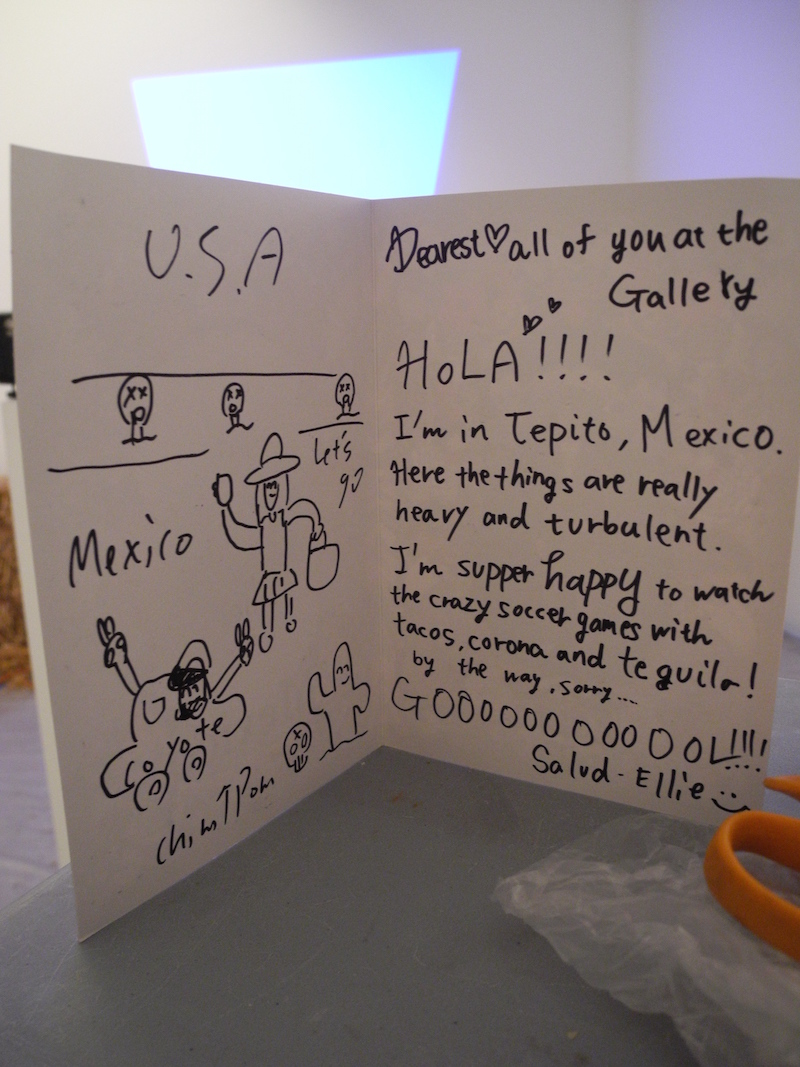
COYOTE
2014
インスタレーション
Courtesy of the artist and MUJIN-TO ProductionCOYOTE
2014
installation
Courtesy of the artist and MUJIN-TO Production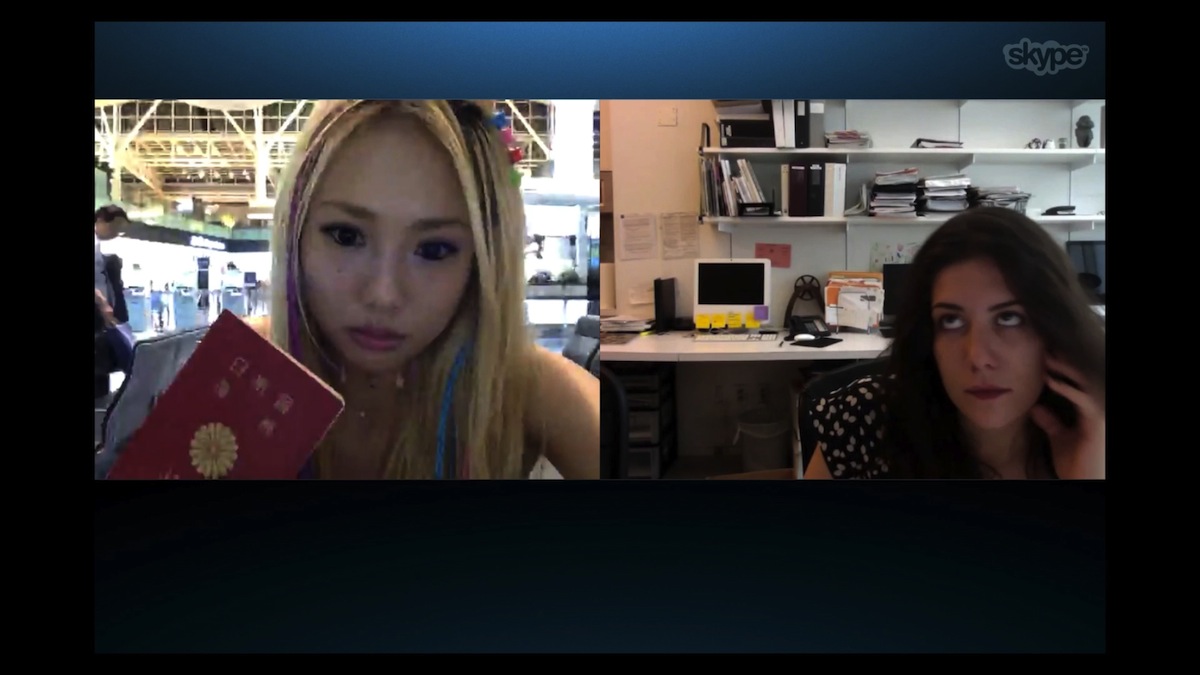
COYOTE
2014
インスタレーション
Courtesy of the artist and MUJIN-TO ProductionCOYOTE
2014
installation
Courtesy of the artist and MUJIN-TO Production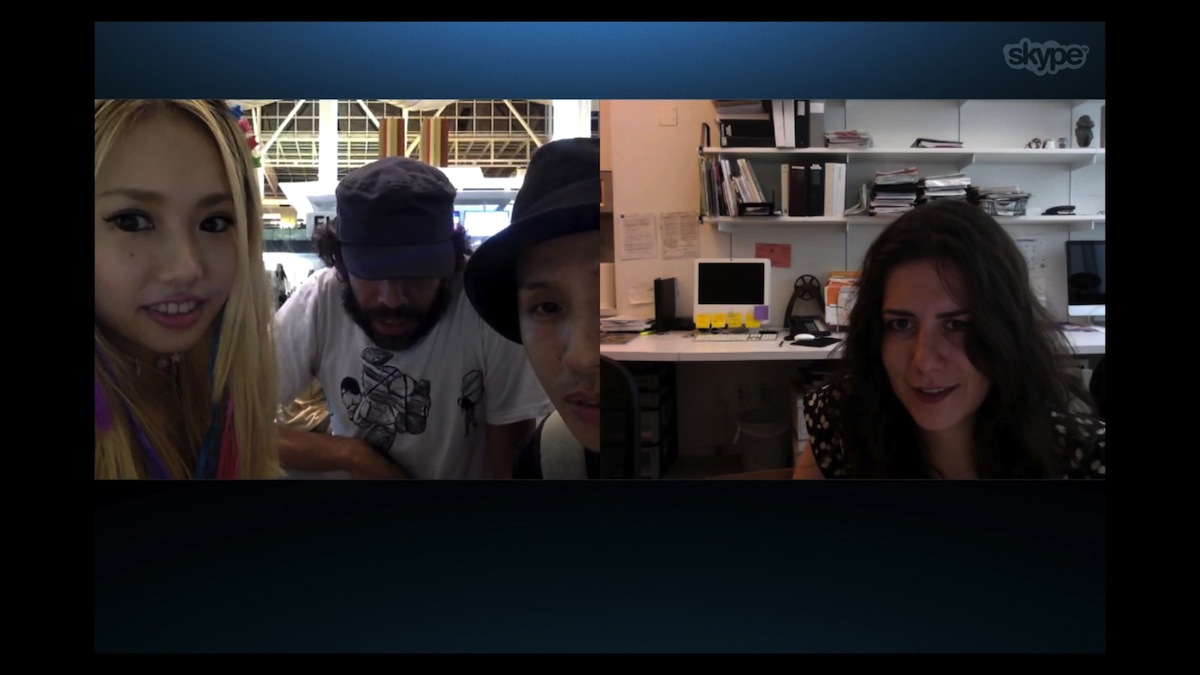
COYOTE
2014
インスタレーション
Courtesy of the artist and MUJIN-TO ProductionCOYOTE
2014
installation
Courtesy of the artist and MUJIN-TO Production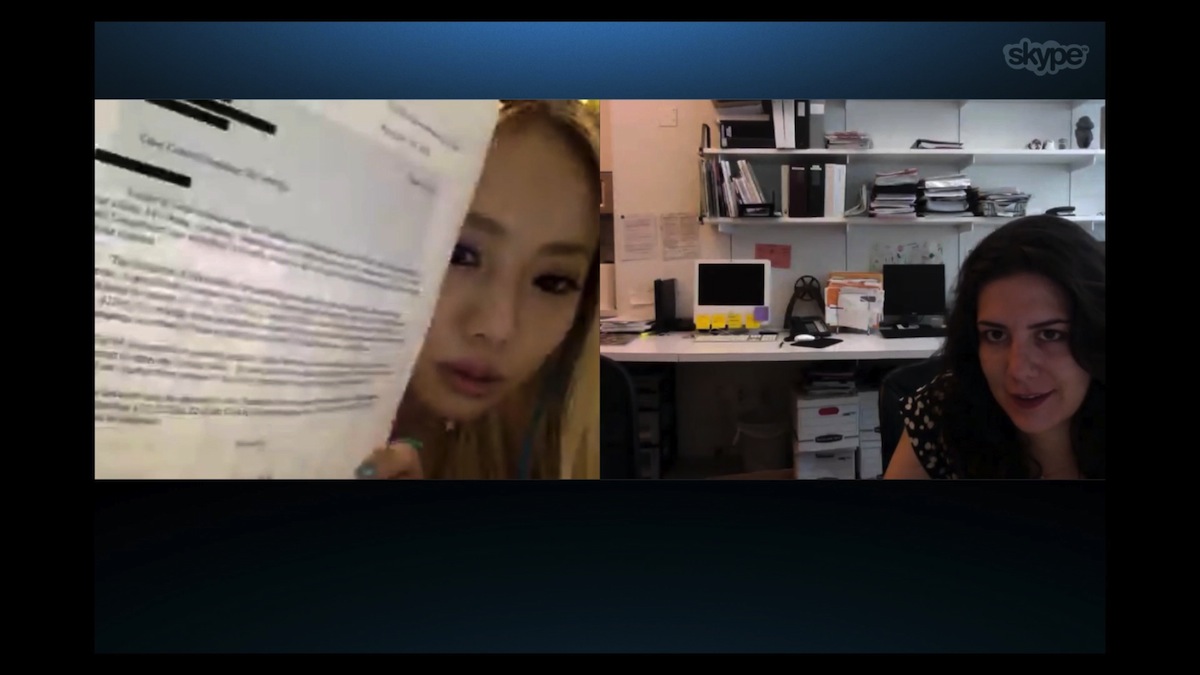
COYOTE
2014
インスタレーション
Courtesy of the artist and MUJIN-TO ProductionCOYOTE
2014
installation
Courtesy of the artist and MUJIN-TO Production
- ---
U.S.A. Visitor CenterU.S.A. Visitor Center open/close -
2016
メキシコのティファナには Libertad(リベルタ/「自由」のスペイン語)と呼ばれる国境沿いのスラム地域があり、多くの人々が住みついている。彼らの家はDIYによって建てられており、国境壁を部屋の壁としたり壁沿いを自宅の庭としたりしている。そこで、Chim↑Pomは今回のプロジェクトの協力者となる家族に出会った。そして、アメリカの目の前に住んでいるが入国できない人々のためのツリーハウスを製作した。
2016
Many people live in Tijuana – a slum located along the border known as Libertad (meaning “liberty” in Spanish) in Mexico. Some of the self-built house that stands next to the border wall utilizes it as part of their own property. There, Chim↑Pom met a family that collaborated with them for this project. They built a tree house in front of the U.S.A., for people who are living there but are unable to enter the country.
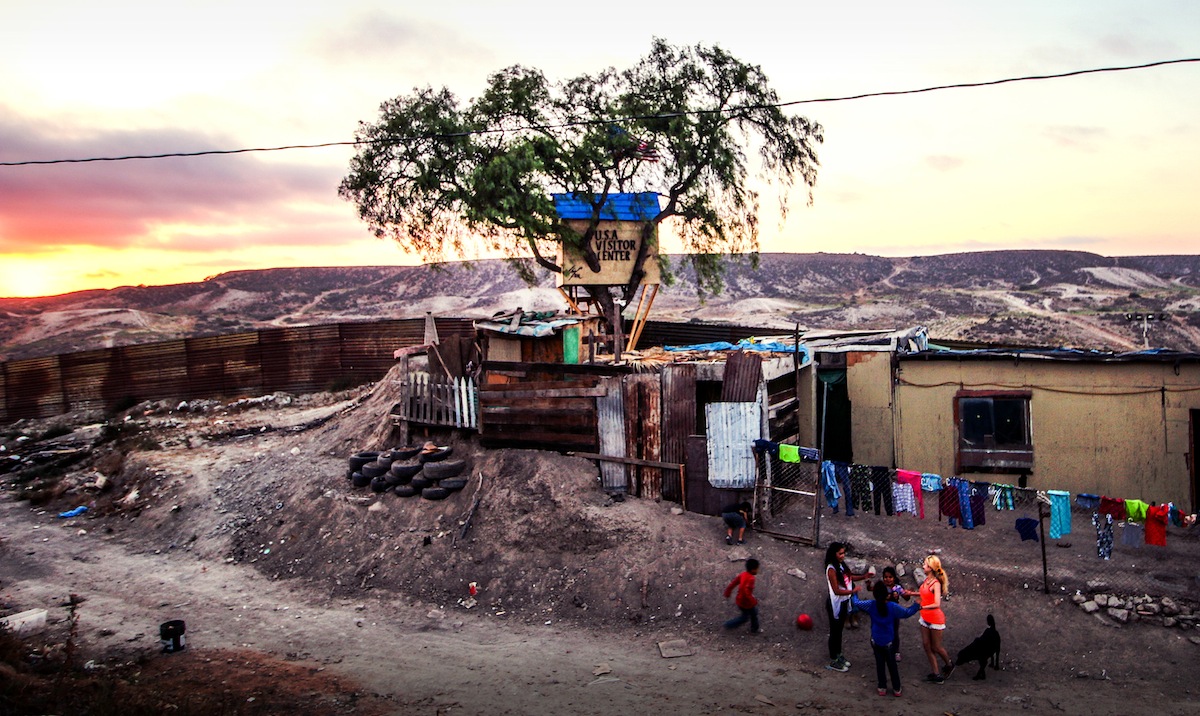
U.S.A. Visitor Center
2017
ジークレープリント(66×100cm)
撮影:松田修
Courtesy of the artist and MUJIN-TO ProductionU.S.A. Visitor Center
2017
Giclee print (66x100cm)
Photo: Osamu Matsuda
Courtesy of the artist and MUJIN-TO Production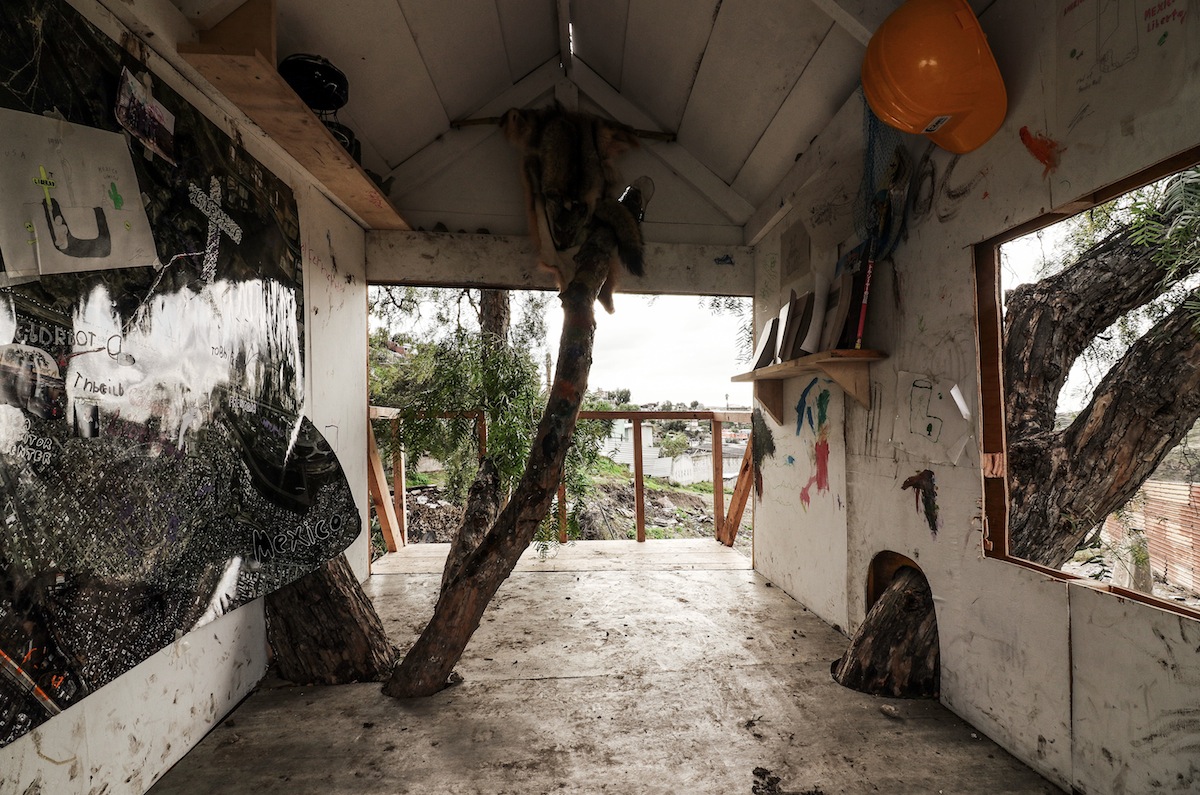
U.S.A. Visitor Center
2017
撮影:松田修
Courtesy of the artist and MUJIN-TO ProductionU.S.A. Visitor Center
2017
Photo: Osamu Matsuda
Courtesy of the artist and MUJIN-TO Production
- ---
The GroundsThe Grounds open/close -
2017
メキシコ側の国境沿いに掘った実際の穴。穴は地中に刺さった国境壁の下、アメリカとメキシコの境界である土にまで掘り進めた。アメリカのオーバーグラウンドには立てないエリイがそこまで潜り込み、アンダーグラウンドでその土に足跡を残すことによって、合法的にアメリカに足を踏み入れるという私的なプロジェクト。その足跡を石膏で型取りした。国境壁の真下である土地はアメリカともメキシコとも言えない領土であることから、タイトルには複数形を用いた。
2017
The Grounds is a real hole dug on the Mexican side along the border. The hole directs towards the border wall that is inserted underground, and continues towards the earth that is shared between the U.S.A. and Mexico. This is a personal project for Ellie – unable to stand above ground level in the U.S.A., she crawled inside and left her footprints at the end of the hole, which is in fact American land. A mold of the footprint is made with plaster. The title of this work adapts a plural form since the ownership of the territory directly under the border wall cannot be specified.
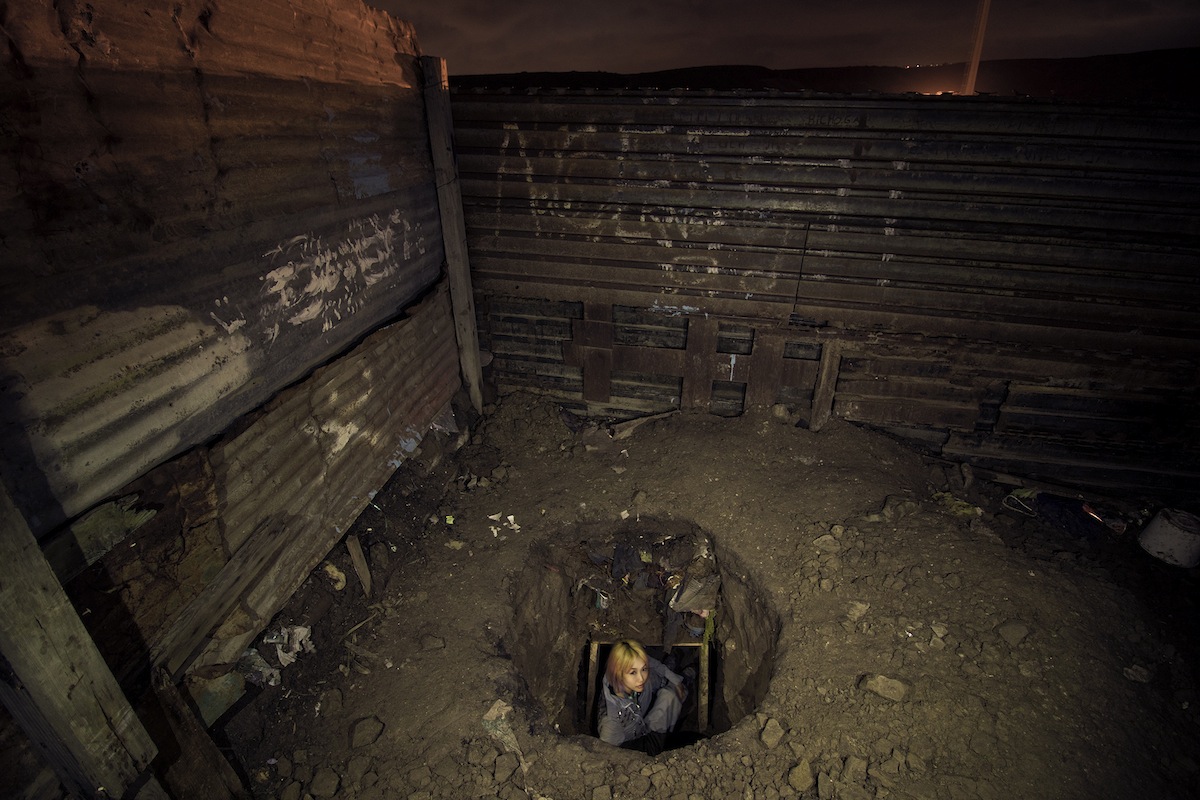
The Grounds
2017
ビデオインスタレーション(ビデオ、石膏、ラムダプリント、アクリルマウント、マニュアル)
撮影:前田ユキ
Courtesy of the artist and MUJIN-TO ProductionThe Grounds
2017
Video installation (video, plaster model, lambda print, acrylic mount, instruction manual)
Photo: Yuki Maeda
Courtesy of the artist and MUJIN-TO Production
The Grounds
2017
ビデオインスタレーション(ビデオ、石膏、ラムダプリント、アクリルマウント、マニュアル)
撮影:前田ユキ
Courtesy of the artist and MUJIN-TO ProductionThe Grounds
2017
Video installation (video, plaster model, lambda print, acrylic mount, instruction manual)
Photo: Yuki Maeda
Courtesy of the artist and MUJIN-TO Production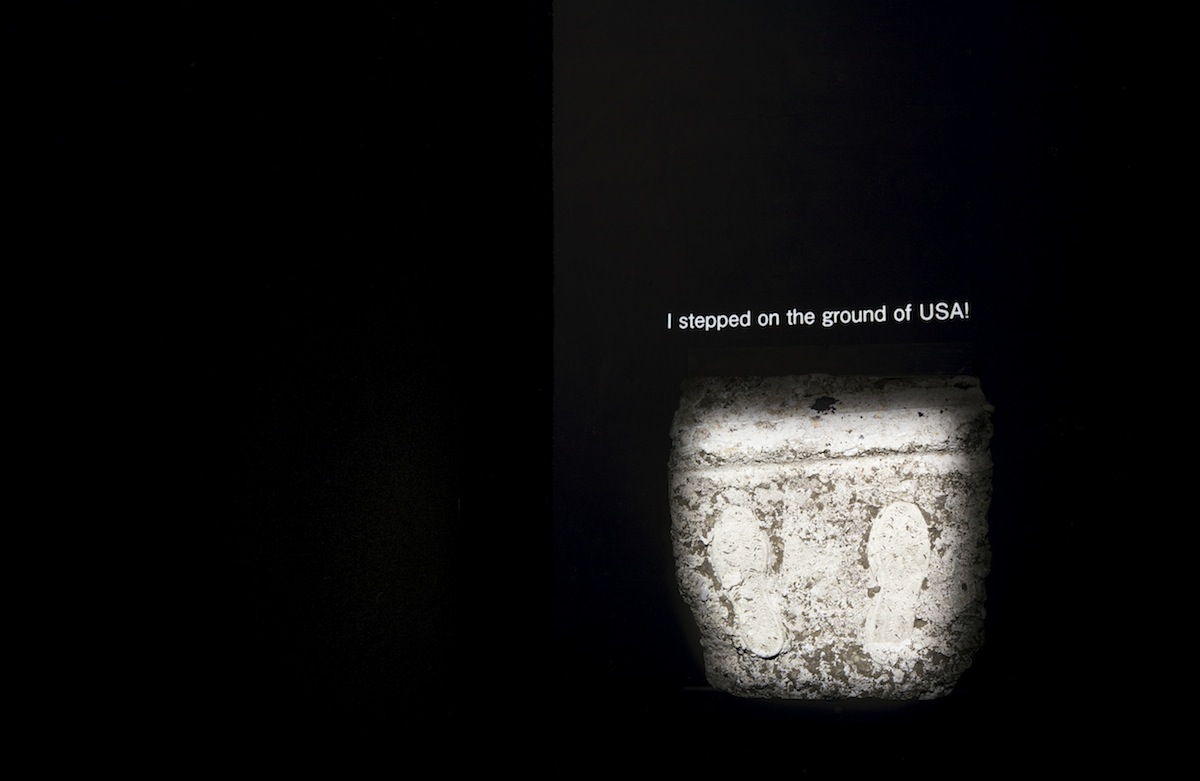
The Grounds
2017
ビデオインスタレーション(ビデオ、石膏、ラムダプリント、アクリルマウント、マニュアル)
撮影:森田兼次
Courtesy of the artist and MUJIN-TO ProductionThe Grounds
2017
Video installation (video, plaster model, lambda print, acrylic mount, instruction manual)
Photo: Kenji Morita
Courtesy of the artist and MUJIN-TO Production
The Grounds
2017
ビデオインスタレーション(ビデオ、石膏、ラムダプリント、アクリルマウント、マニュアル)
撮影:森田兼次
Courtesy of the artist and MUJIN-TO ProductionThe Grounds
2017
Video installation (video, plaster model, lambda print, acrylic mount, instruction manual)
Photo: Kenji Morita
Courtesy of the artist and MUJIN-TO Production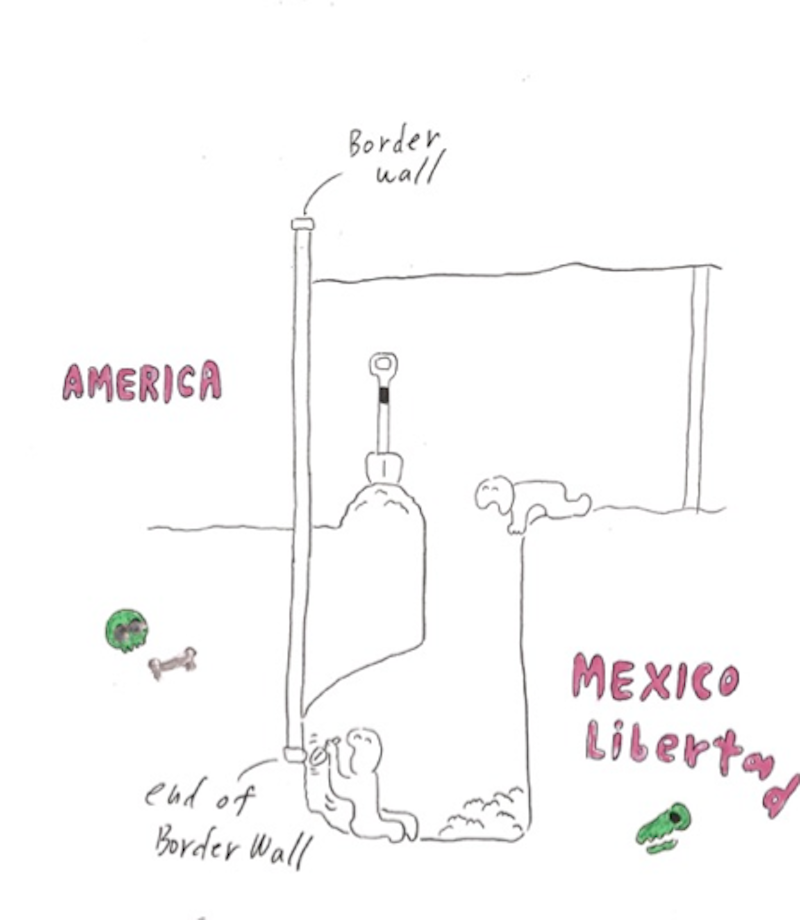
The Grounds
2017
Courtesy of the artist and MUJIN-TO ProductionThe Grounds
2017
Courtesy of the artist and MUJIN-TO Production
- ---
LIBERTADLIBERTAD open/close -
2017
アメリカ側に設置された作品。現在、国境には新旧二つの壁があり、その壁の間にはアメリカ政府管轄の、特に厳しく立ち入りが制限された「ノーマンズランド」と呼ばれるゾーンが存在する。けれどもそこは、近所のメキシコ人にとっては生活圏の一部でもある。Chim↑Pomは「コロニア・リベルタ」と呼ばれるメキシコ側の地域に通い、現地の人々とともに「チーム・リベルタ」を結成。ノーマンズランドにFRP で制作した穴と十字架、スコップを、メキシコ側に設置された本物の穴の作品《The Grounds》と対になるように設置した。それは、その土地に複数あるとされる違法トンネルを想起させる。そこが墓であることを意味する十字架には、穴の向こう側の地名である「LIBERTAD」、つまり「自由」という想像上の主の名前が書かれている。
2017
This work was placed on the American side. There is a new and an old wall along the border, and in between that a severely controlled “no-man-zone” that is under the jurisdiction of the American government. In fact, this area has become part of the daily lives of the local Mexican residents. Chim↑Pom went to an area called “Colonia Libertad” on the Mexican side to form “Team LIBERTAD” with the local people. They installed a hole, a cross and a shovel all made with plastic there, against the original work of The Grounds that is installed on the Mexican side. It strongly suggests the multiple illegal tunnels that exist in that area. The cross that represents a grave is labeled “LIBERTAD” - the name of the place on the other side - bringing forward the idea that “liberty” is only an imaginative concept. This piece was created precisely to build a grave for the idea of liberty on American land.

LIBERTAD
2017
ドキュメントビデオ
Courtesy of the artist and MUJIN-TO ProductionLIBERTAD
2017
Documentation Video
Courtesy of the artist and MUJIN-TO Production
LIBERTAD
2017
ドキュメントビデオ
Courtesy of the artist and MUJIN-TO ProductionLIBERTAD
2017
Documentation Video
Courtesy of the artist and MUJIN-TO Production
LIBERTAD
2017
ドキュメントビデオ
Courtesy of the artist and MUJIN-TO ProductionLIBERTAD
2017
Documentation Video
Courtesy of the artist and MUJIN-TO Production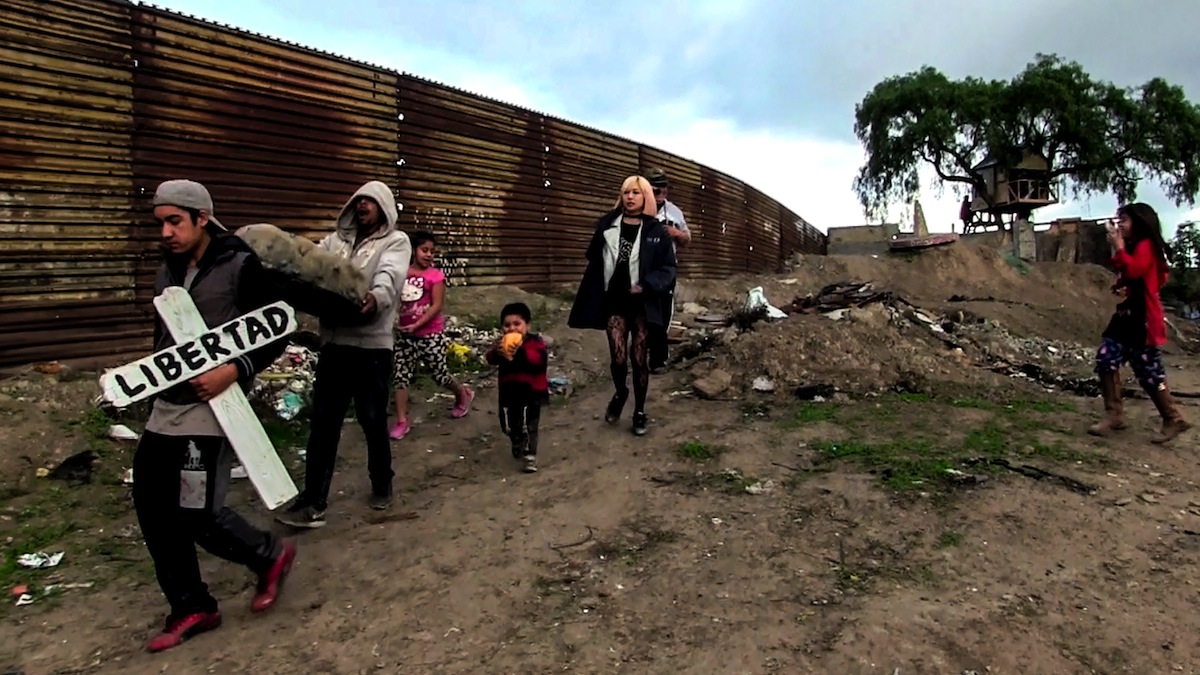
LIBERTAD
2017
ドキュメントビデオ
Courtesy of the artist and MUJIN-TO ProductionLIBERTAD
2017
Documentation Video
Courtesy of the artist and MUJIN-TO Production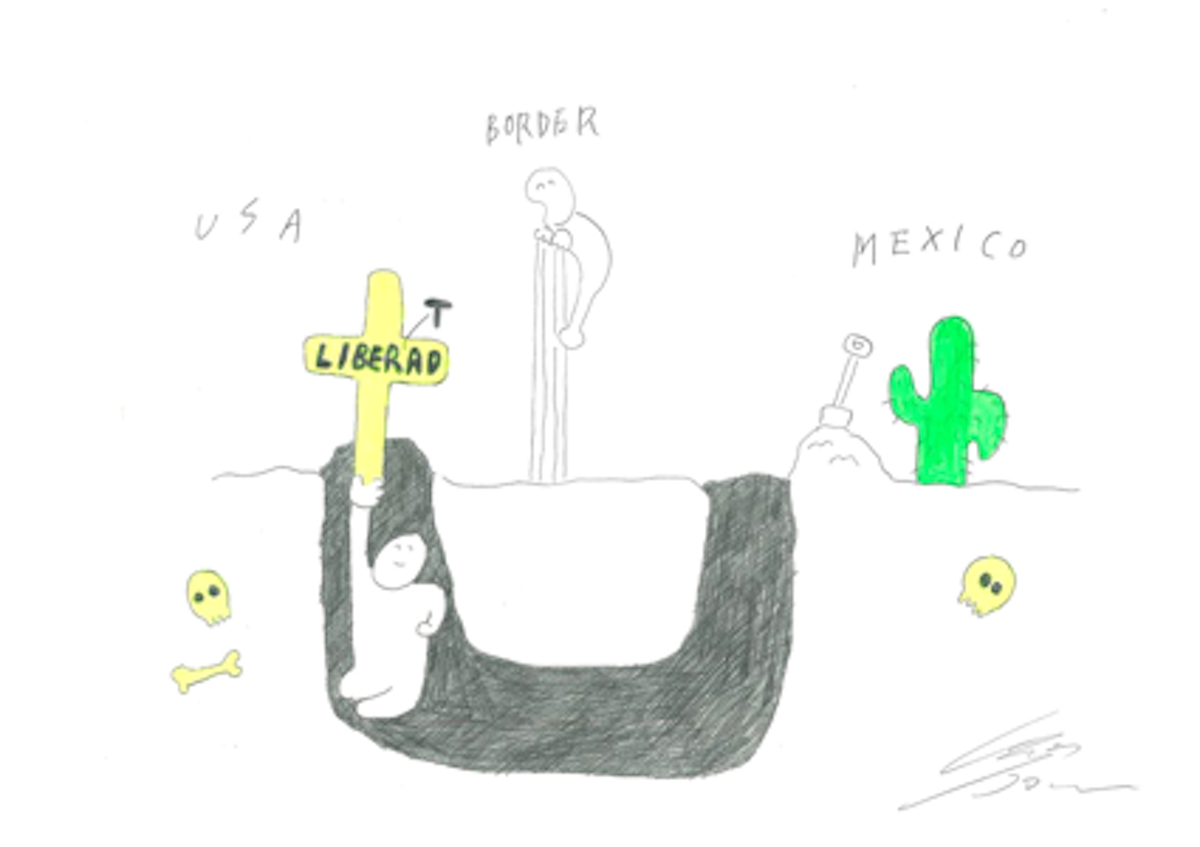
LIBERTAD
2017
Courtesy of the artist and MUJIN-TO ProductionLIBERTAD
2017
Courtesy of the artist and MUJIN-TO Production
LIBERTAD
2017
Courtesy of the artist and MUJIN-TO ProductionLIBERTAD
2017
Courtesy of the artist and MUJIN-TO Production
- ---
Installation viewInstallation view open/close -
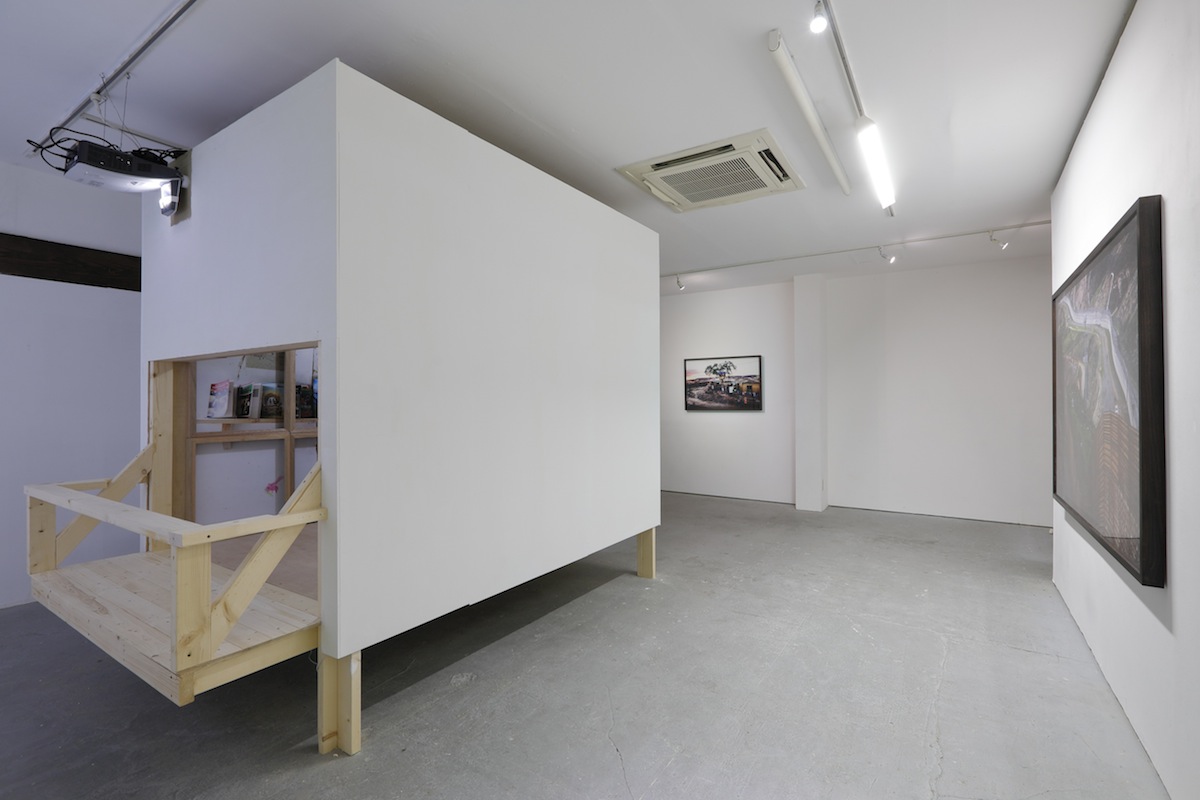
The other side
展示風景:「The other side」(無人島プロダクション、東京、2017年)
撮影:森田兼次
Courtesy of the artist and MUJIN-TO ProductionThe other side
Installation view: “The other side” (MUJIN-TO Production, Tokyo, 2017)
Photo: Kenji Morita
Courtesy of the artist and MUJIN-TO Production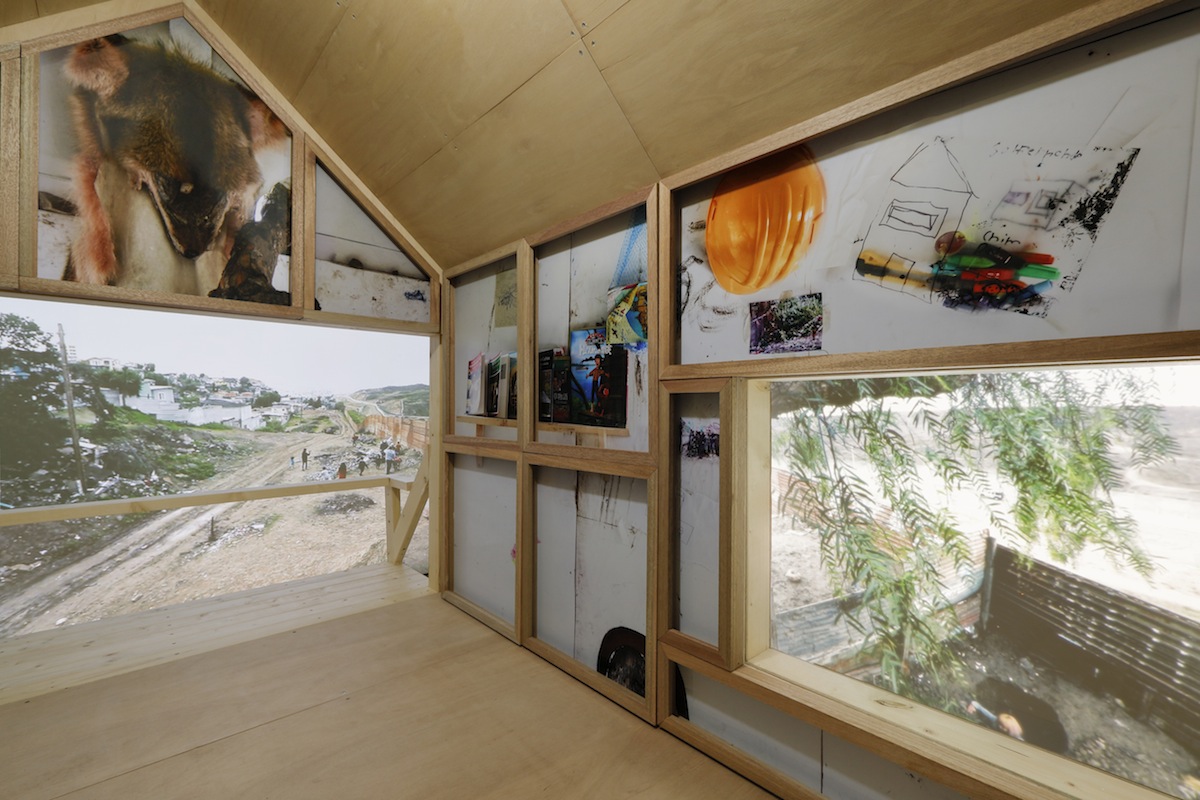
The other side
展示風景:「The other side」(無人島プロダクション、東京、2017年)
撮影:森田兼次
Courtesy of the artist and MUJIN-TO ProductionThe other side
Installation view: “The other side” (MUJIN-TO Production, Tokyo, 2017)
Photo: Kenji Morita
Courtesy of the artist and MUJIN-TO Production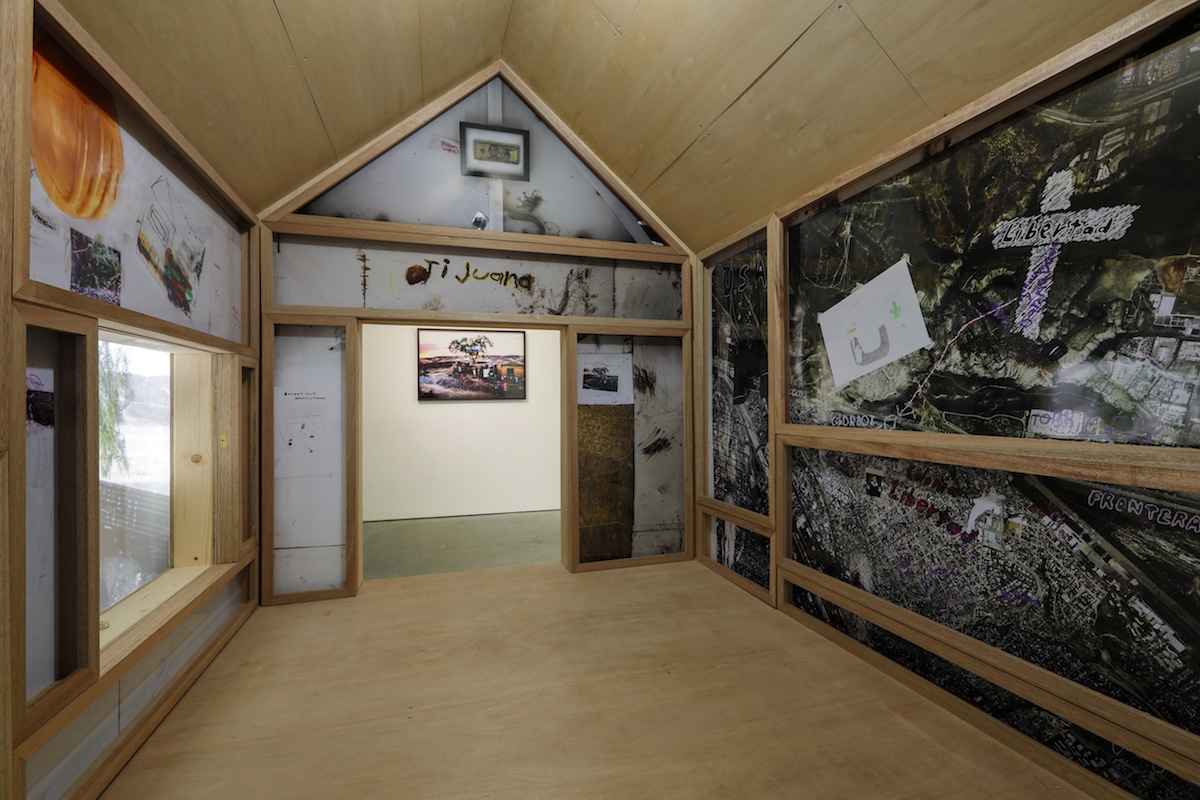
The other side
展示風景:「The other side」(無人島プロダクション、東京、2017年)
撮影:森田兼次
Courtesy of the artist and MUJIN-TO ProductionThe other side
Installation view: “The other side” (MUJIN-TO Production, Tokyo, 2017)
Photo: Kenji Morita
Courtesy of the artist and MUJIN-TO Production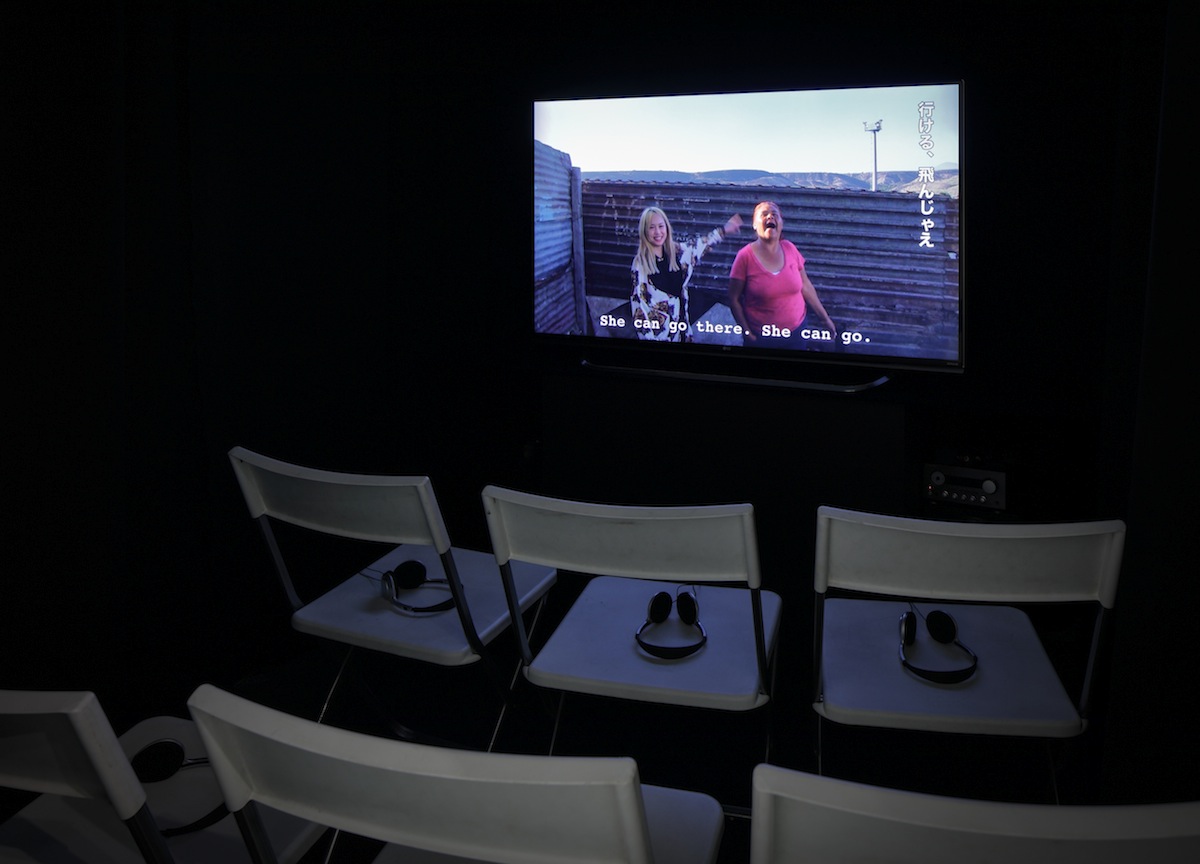
The other side
展示風景:「The other side」(無人島プロダクション、東京、2017年)
撮影:森田兼次
Courtesy of the artist and MUJIN-TO ProductionThe other side
Installation view: “The other side” (MUJIN-TO Production, Tokyo, 2017)
Photo: Kenji Morita
Courtesy of the artist and MUJIN-TO Production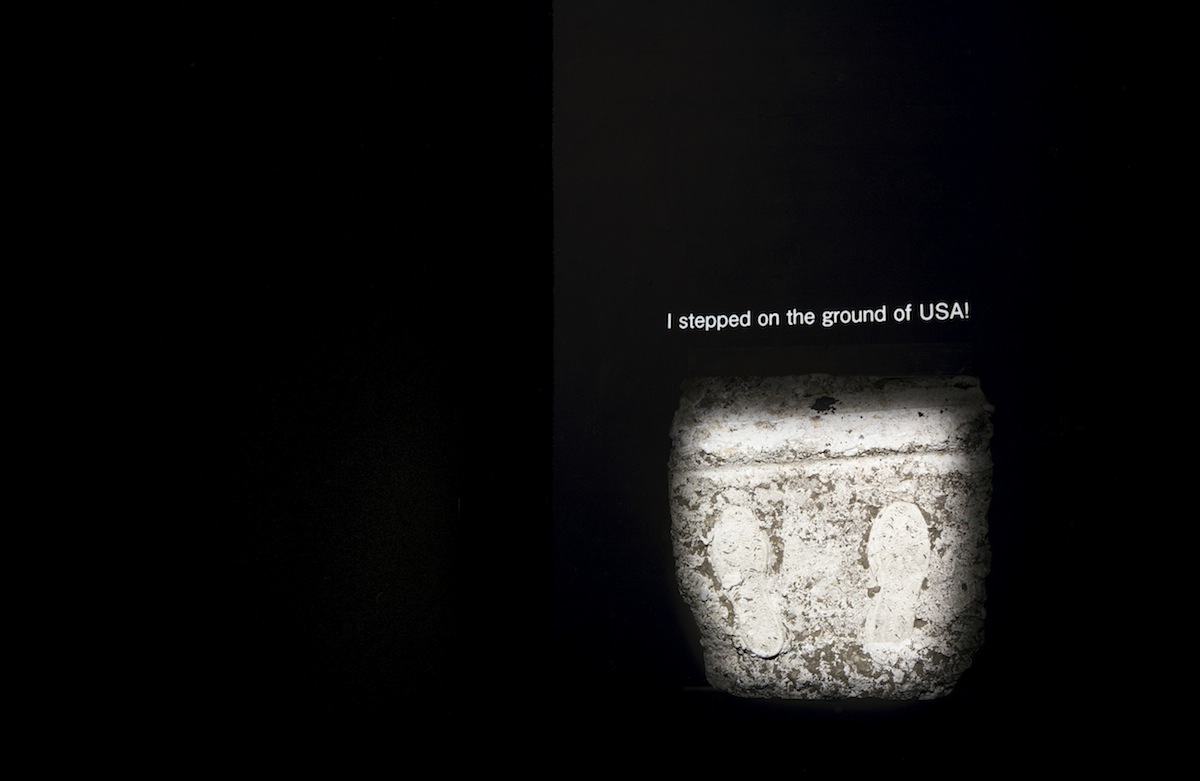
The other side
展示風景:「The other side」(無人島プロダクション、東京、2017年)
撮影:森田兼次
Courtesy of the artist and MUJIN-TO ProductionThe other side
Installation view: “The other side” (MUJIN-TO Production, Tokyo, 2017)
Photo: Kenji Morita
Courtesy of the artist and MUJIN-TO Production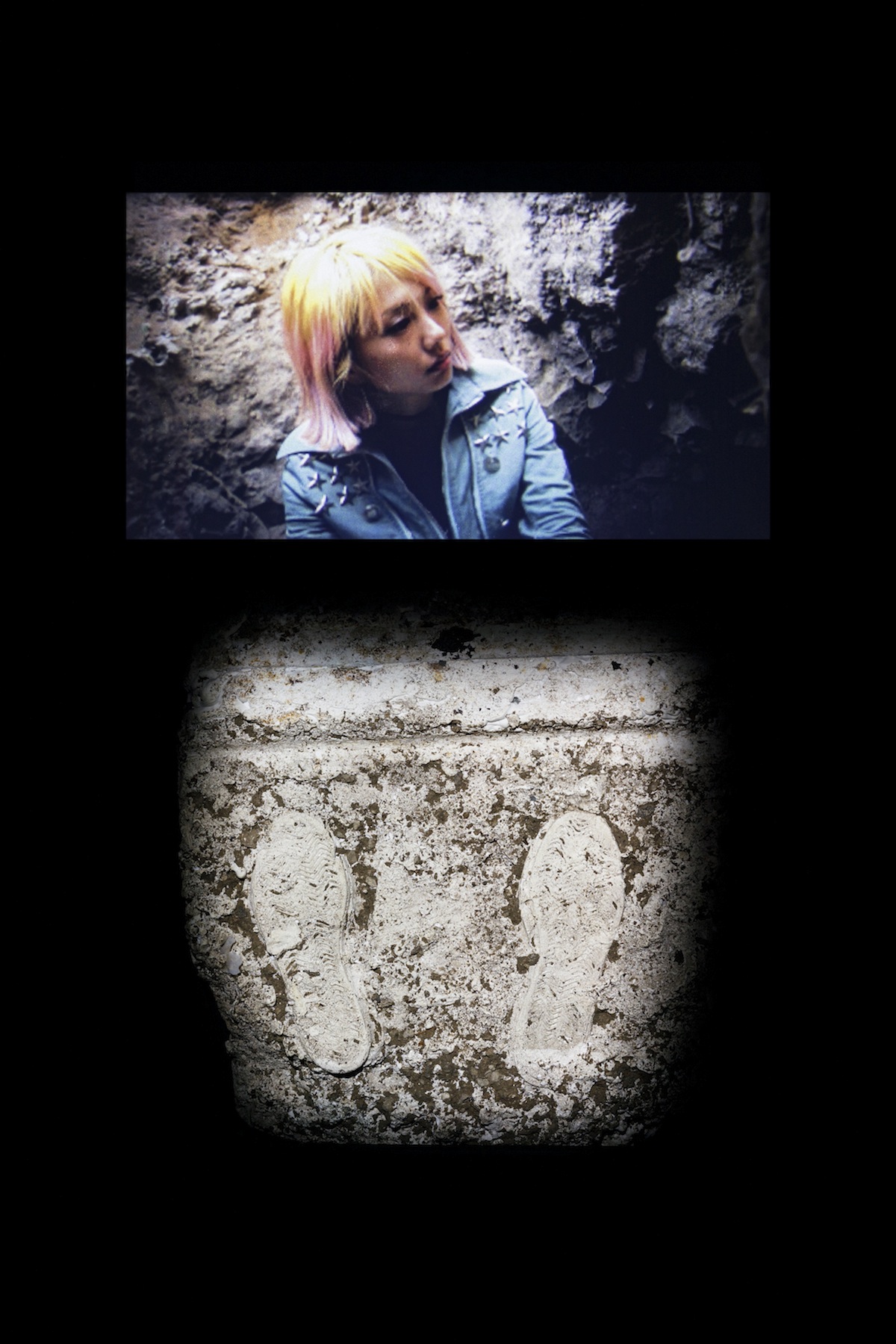
The other side
展示風景:「The other side」(無人島プロダクション、東京、2017年)
撮影:森田兼次
Courtesy of the artist and MUJIN-TO ProductionThe other side
Installation view: “The other side” (MUJIN-TO Production, Tokyo, 2017)
Photo: Kenji Morita
Courtesy of the artist and MUJIN-TO Production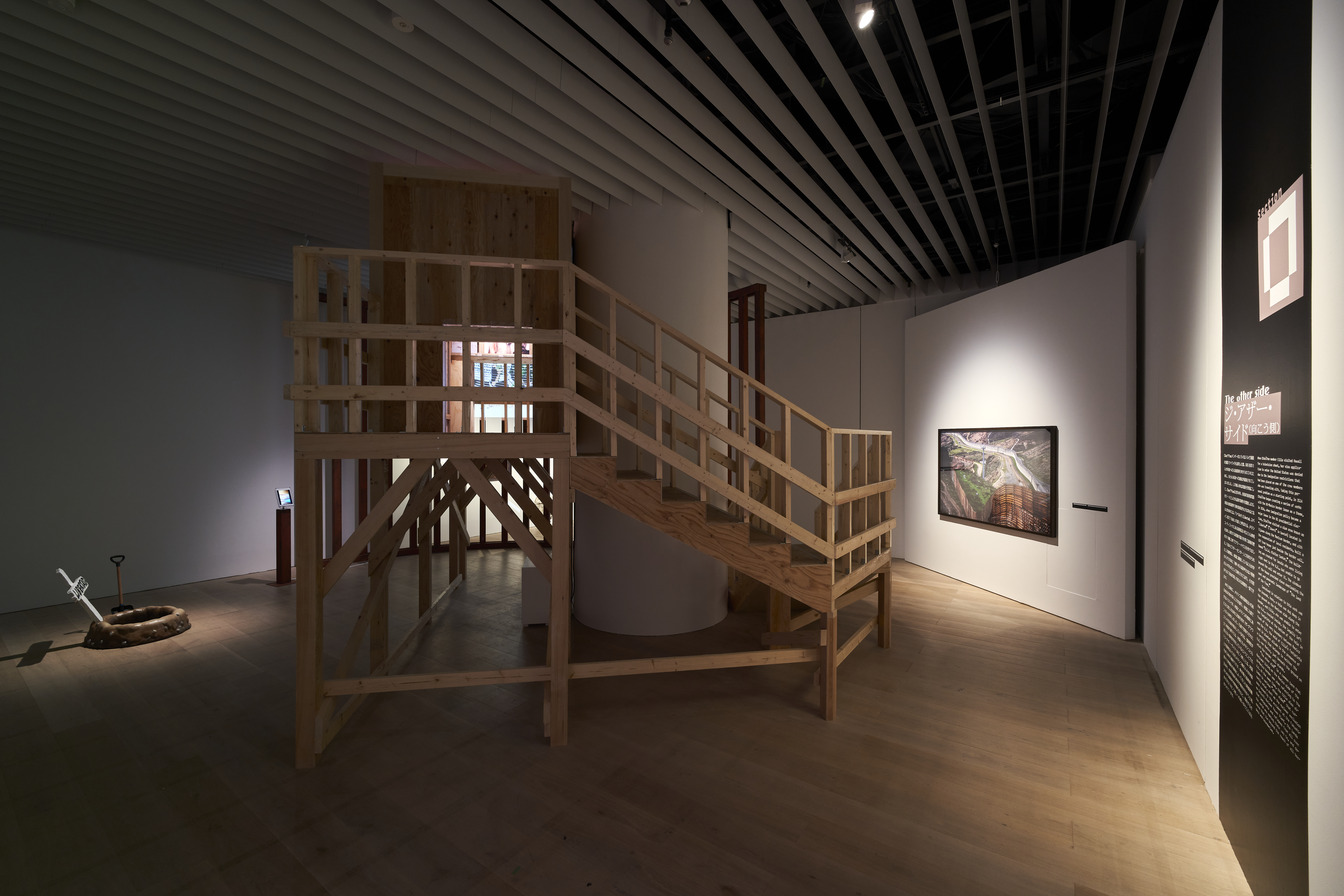
The other sideThe other side
2017/2022 サイズ可変
展示風景:「Chim↑Pom展:ハッピースプリング」森美術館(東京)2022年
撮影:森田兼次
画像提供:森美術館2017/2022 Dimensions Variable
Installation view: Chim↑Pom: Happy Spring, Mori Art Museum, Tokyo, 2022
Photo: Kenji Morita
Photo courtesy: Mori Art Museum, Tokyo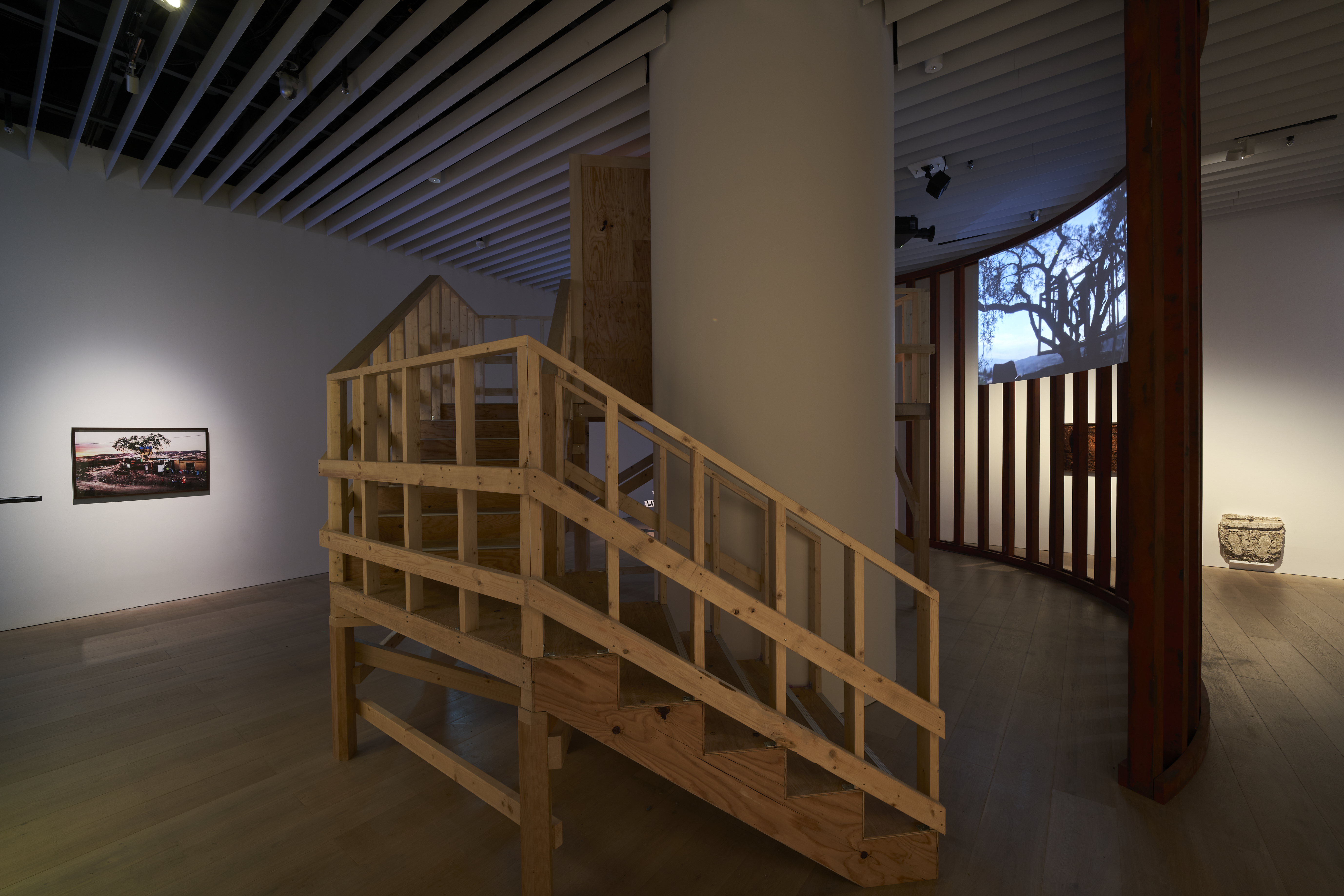
The other sideThe other side
2017/2022 サイズ可変
展示風景:「Chim↑Pom展:ハッピースプリング」森美術館(東京)2022年
撮影:森田兼次
画像提供:森美術館2017/2022 Dimensions Variable
Installation view: Chim↑Pom: Happy Spring, Mori Art Museum, Tokyo, 2022
Photo: Kenji Morita
Photo courtesy: Mori Art Museum, Tokyo
The other sideThe other side
2017/2022 サイズ可変
展示風景:「Chim↑Pom展:ハッピースプリング」森美術館(東京)2022年
撮影:森田兼次
画像提供:森美術館2017/2022 Dimensions Variable
Installation view: Chim↑Pom: Happy Spring, Mori Art Museum, Tokyo, 2022
Photo: Kenji Morita
Photo courtesy: Mori Art Museum, Tokyo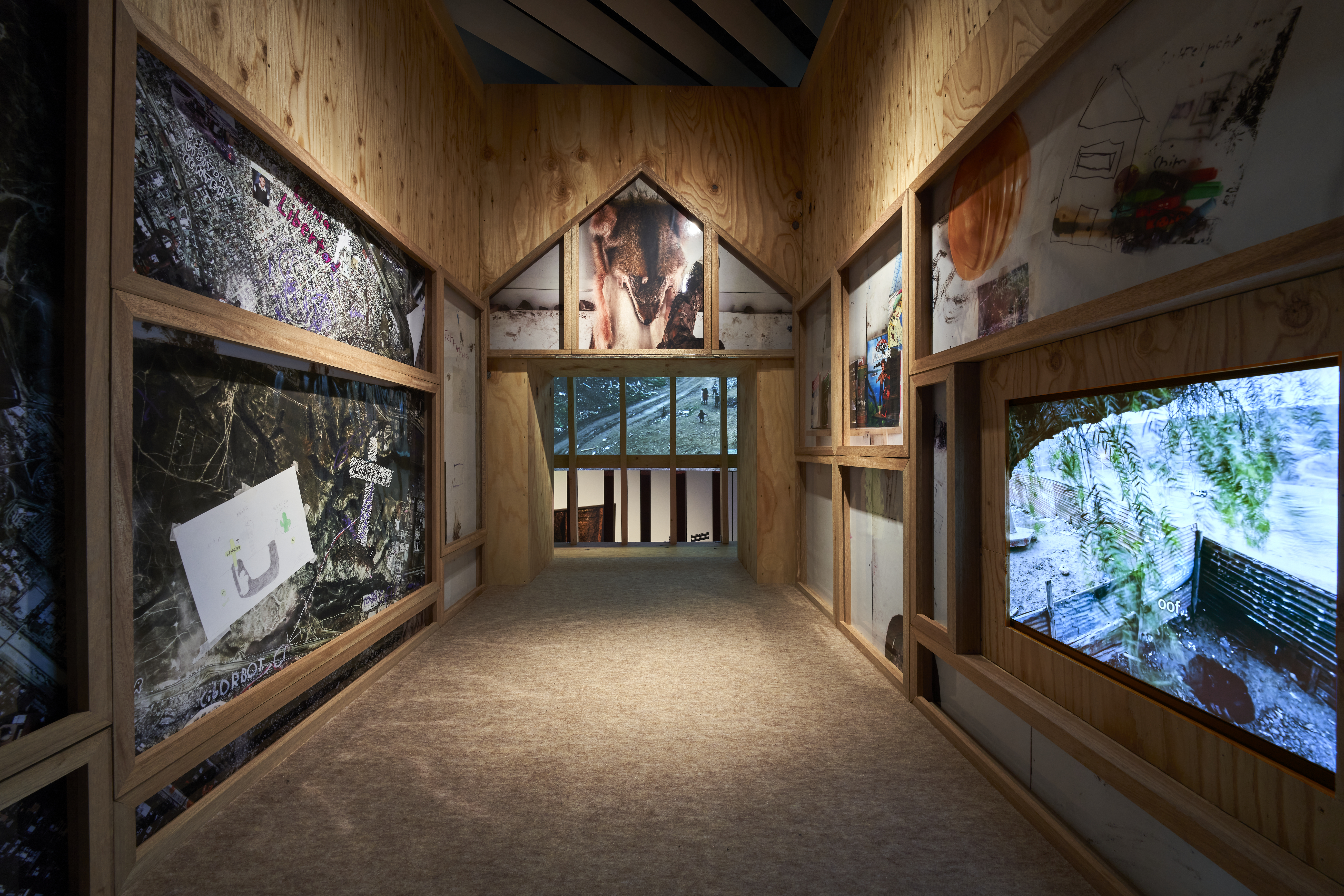
The other sideThe other side
2017/2022 サイズ可変
展示風景:「Chim↑Pom展:ハッピースプリング」森美術館(東京)2022年
撮影:森田兼次
画像提供:森美術館2017/2022 Dimensions Variable
Installation view: Chim↑Pom: Happy Spring, Mori Art Museum, Tokyo, 2022
Photo: Kenji Morita
Photo courtesy: Mori Art Museum, Tokyo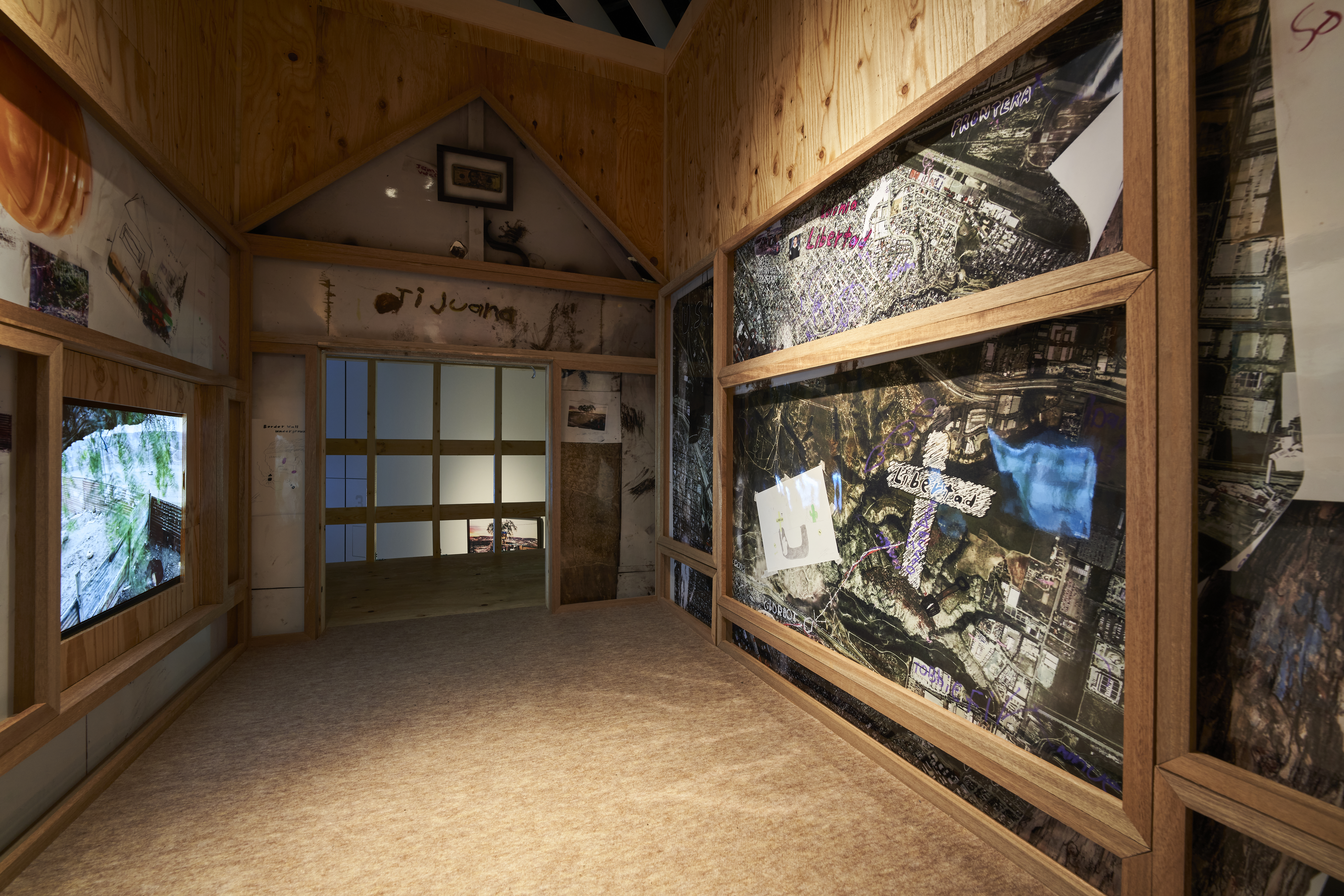
The other sideThe other side
2017/2022 サイズ可変
展示風景:「Chim↑Pom展:ハッピースプリング」森美術館(東京)2022年
撮影:森田兼次
画像提供:森美術館2017/2022 Dimensions Variable
Installation view: Chim↑Pom: Happy Spring, Mori Art Museum, Tokyo, 2022
Photo: Kenji Morita
Photo courtesy: Mori Art Museum, Tokyo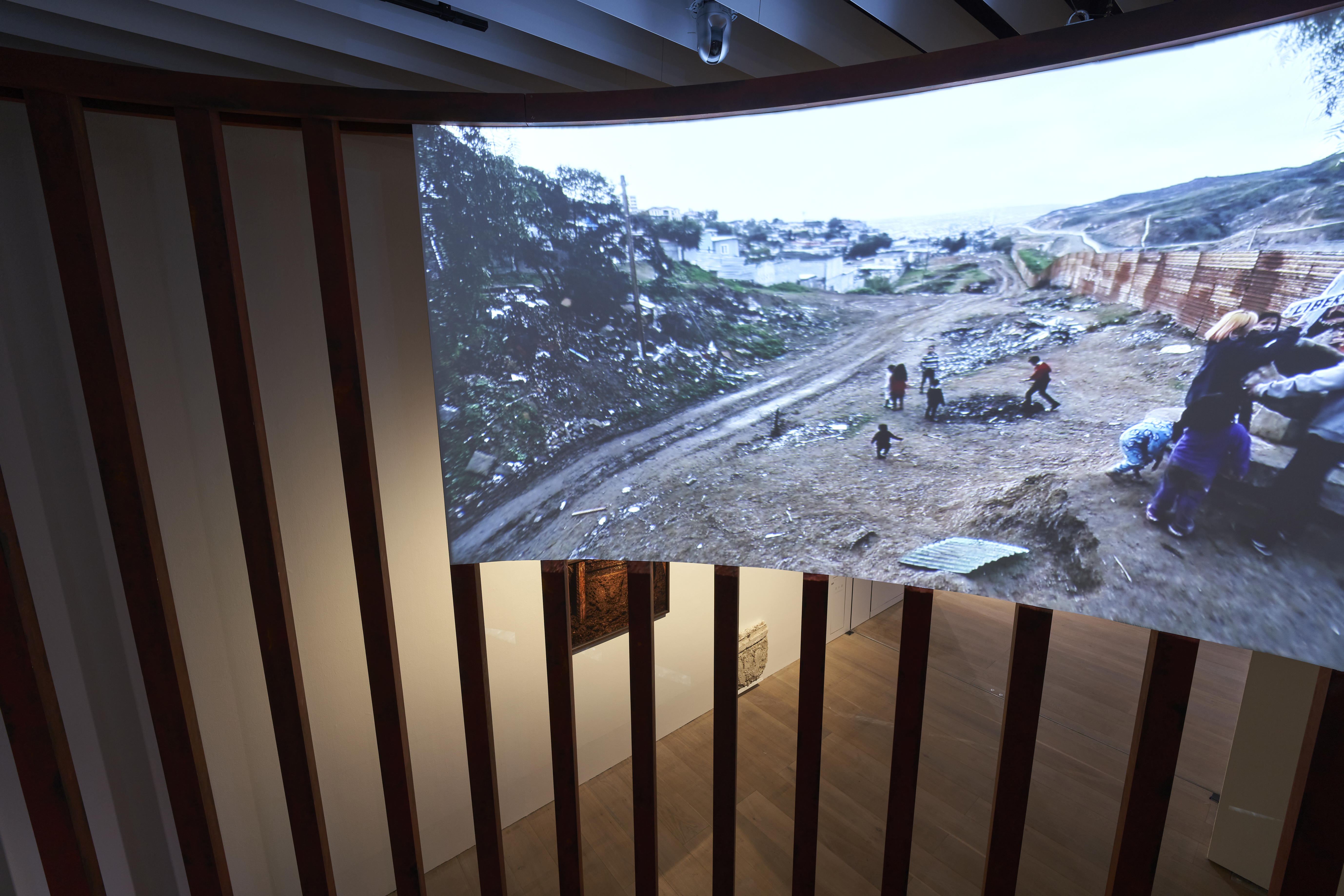
The other sideThe other side
2017/2022 サイズ可変
展示風景:「Chim↑Pom展:ハッピースプリング」森美術館(東京)2022年
撮影:森田兼次
画像提供:森美術館2017/2022 Dimensions Variable
Installation view: Chim↑Pom: Happy Spring, Mori Art Museum, Tokyo, 2022
Photo: Kenji Morita
Photo courtesy: Mori Art Museum, Tokyo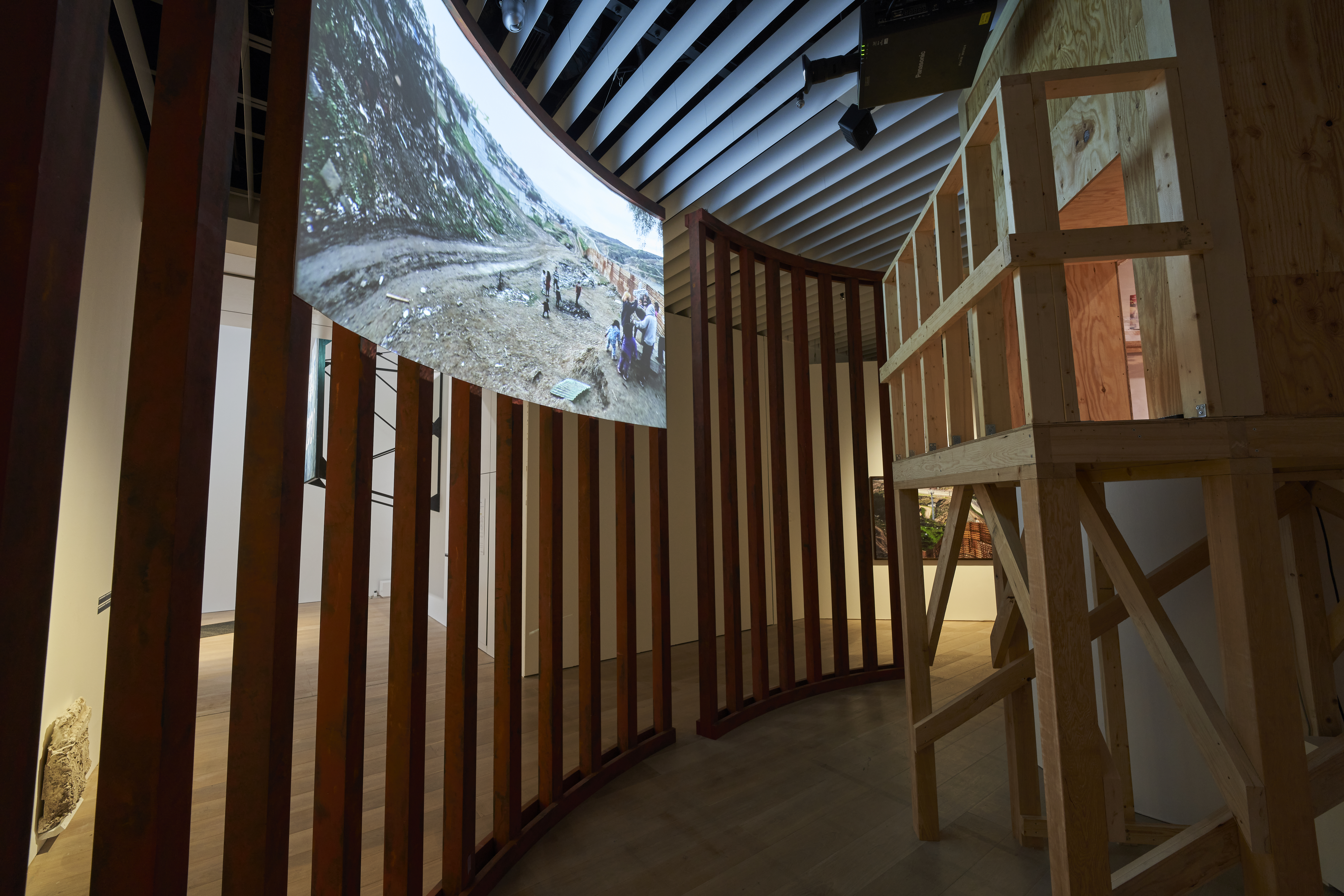
The other sideThe other side
2017/2022 サイズ可変
展示風景:「Chim↑Pom展:ハッピースプリング」森美術館(東京)2022年
撮影:森田兼次
画像提供:森美術館2017/2022 Dimensions Variable
Installation view: Chim↑Pom: Happy Spring, Mori Art Museum, Tokyo, 2022
Photo: Kenji Morita
Photo courtesy: Mori Art Museum, Tokyo
The other sideThe other side
2017/2022 サイズ可変
展示風景:「Chim↑Pom展:ハッピースプリング」森美術館(東京)2022年
撮影:森田兼次
画像提供:森美術館2017/2022 Dimensions Variable
Installation view: Chim↑Pom: Happy Spring, Mori Art Museum, Tokyo, 2022
Photo: Kenji Morita
Photo courtesy: Mori Art Museum, Tokyo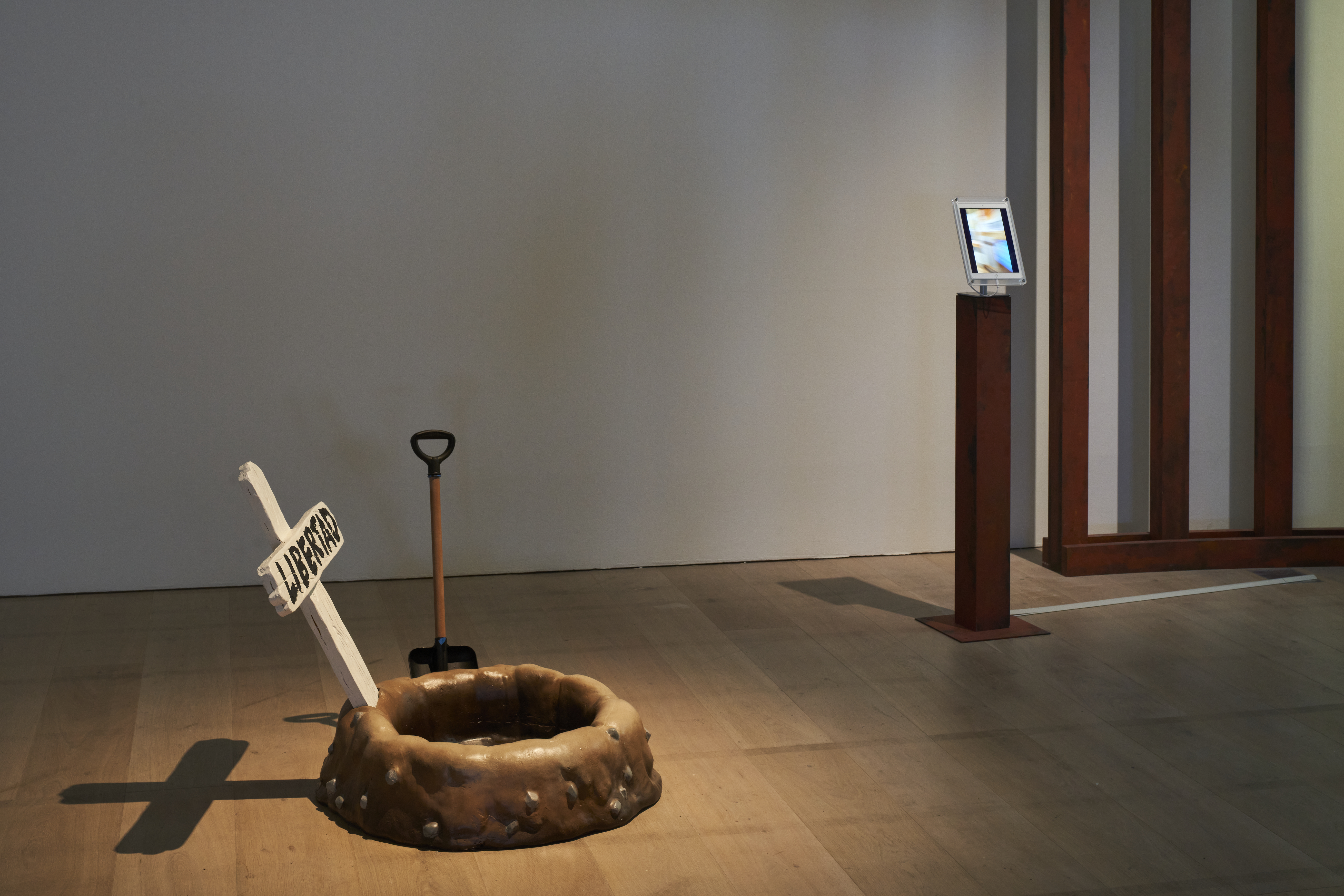
The other sideThe other side
2017/2022 サイズ可変
展示風景:「Chim↑Pom展:ハッピースプリング」森美術館(東京)2022年
撮影:森田兼次
画像提供:森美術館2017/2022 Dimensions Variable
Installation view: Chim↑Pom: Happy Spring, Mori Art Museum, Tokyo, 2022
Photo: Kenji Morita
Photo courtesy: Mori Art Museum, Tokyo
